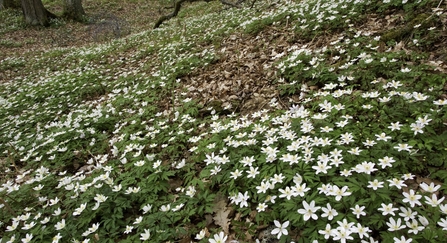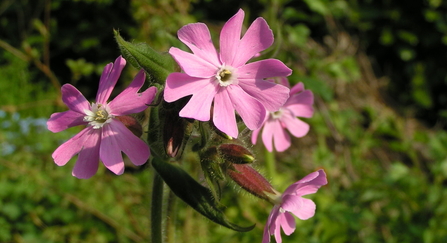Ancient woodland plants

Credit: Philip Precey
Lily of the Valley (Convallaria majalis) is a native flowering plant, with bell shaped white flowers dangling from the main stem. They are also known as May bells and Our Lady’s tears. The second name refers to a biblical connection, as it is said to have first flowered in the Garden of Eden when Eve left the garden and her tears left flowers behind.
They can be seen in woodlands throughout May to June and are indicators of ancient woodland. Lily of the Valley prefer dry and chalky soils. They are a valuable pollen source for bees, which are attracted to the white flower’s sweet scent.
The flowers have strong connections to fairies, and are thought to bring luck in love, and are therefore popular in wedding bouquets. In the past, the flowers were made into a tonic which was used to treat heart problems in traditional medicine. But the plant is actually very poisonous and should be avoided!
Wood Anemone

Credit: Mark Hamblin/2020VISION
Wood anemones (Anemone nemorosa) are some of the first woodland plants to flower, as they are a sun-loving plant which makes the most of the canopy being leafless in early spring. They are white star-shaped flowers, with lots of yellow anthers covered in pollen in the centre. Wood anemones are named after the Greek god Anemos, who is said to have sent the flowers ahead of him in spring. They are also known as windflowers.
Wood anemone are an ancient woodland indicator species, found in mature deciduous woodlands. Wood anemones are a slow growing species, which spreads via rhizomes (horizontal underground stems), which cover the woodland floor. They are a native species found throughout March to May, and are members of the Buttercup family. These flowers are thought to rely significantly on hoverflies as pollinators.
Bluebells
Bluebells at Hagbourne Copse nature reserve in Wiltshire. Credit: Eleanor Dodson.
Bluebells (Hyacinthoides non-scripta) are an iconic spring favourite across the UK and are a native species which flower from mid-April into late May. They have bright violet-coloured bells which hang down from a main stem to one side.
They are an indicator of ancient woodland, and also grow along hedgerows and in fields. Bluebells flower earlier than other UK species, and so provides a good food source for woodland butterflies, bees and hoverflies. Interestingly, bees can bypass pollinating the flower and steal the nectar by biting a hole in the bottom of the flower.
Bluebell woods are believed in folklore to trap humans. If you hear a bluebell ring, you will be visited by a bad fairy and if you pick one, you will be led astray by fairies and wander lost forever. In traditional medicine, their sticky sap was used to bind pages of books and glue feathers onto arrows. However, bluebells are toxic, and careful work is being done by scientists to see if any of these properties could potentially help fight cancer.
Bluebell colonies take 5 -7 years to establish from seed to flower. if the leaves are crushed, they die back from lack of food as the leaves cannot photosynthesise. And so, they can take years to recover from footfall damage - so please stick to the paths! Bluebells are protected under the Wildlife and Countryside Act (1981) and the Schedule 8 of the Act in 1998.
Our Hagbourne Copse nature reserve in Wroughton, Swindon, is the ideal location to view these carpets of blue.
Red Campion

Credit: Richard Burkmar
After the bluebells have finished flowering, the pink flowers of Red campion (Silene dioica) bloom from May to September.
Red campion are also known as Robin Hood and adder’s flower. In traditional medicine, red campion seeds were used to treat snakebites. In folklore, red campion flowers are said to guard bees’ honey stores and protecting fairies from being discovered. These native flowers are found in woodland, grassland and also urban areas. Red campion have hairy leaves, and have five pink petals.
They are often found along hedgerows and in fields and ditches on roadside verges – they prefer lightly shaded areas. Red campion is an ancient woodland indicator plant and they are an important source for pollinators including bees, butterflies and hoverflies.
Want to see more ancient woodland plants?


